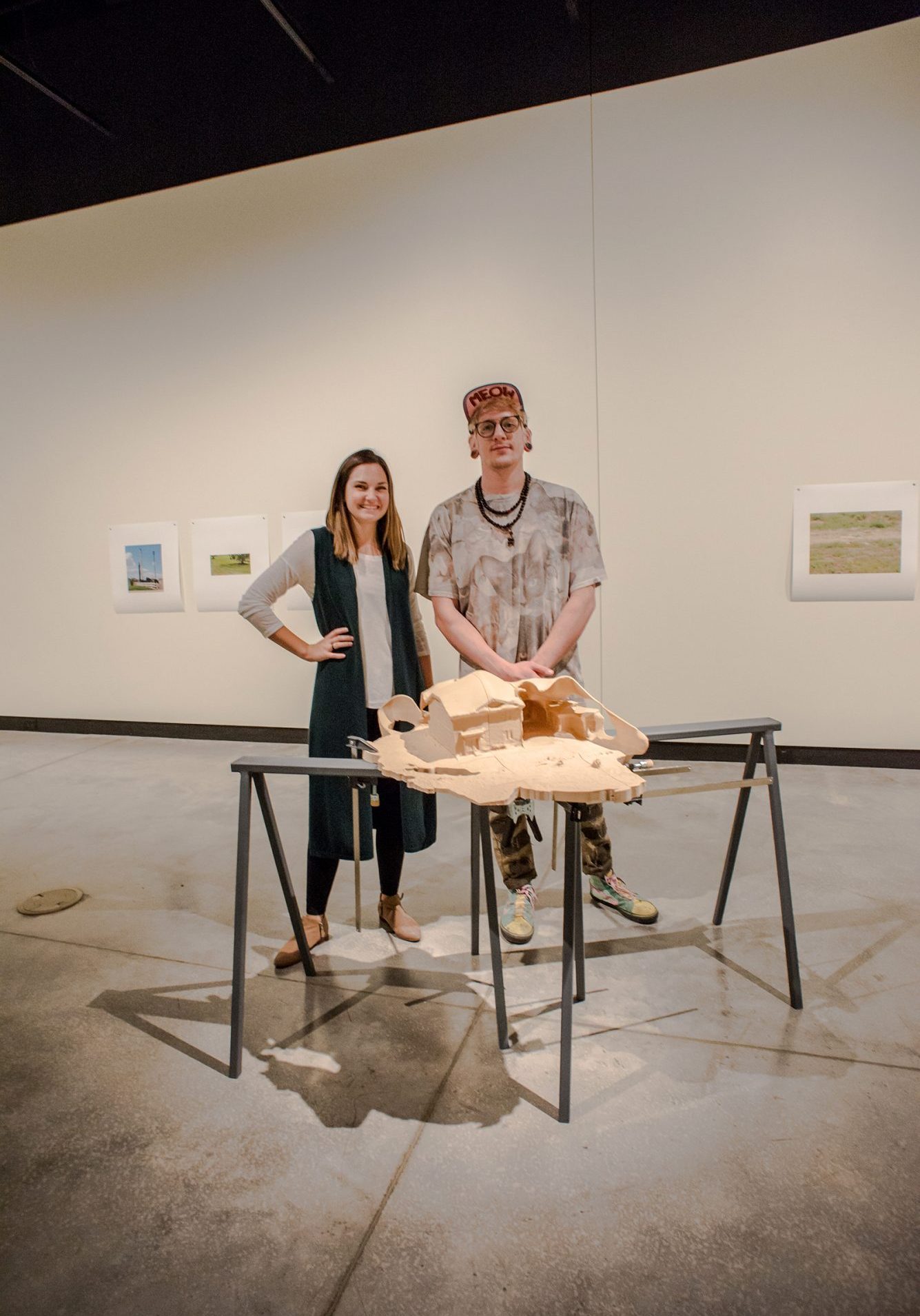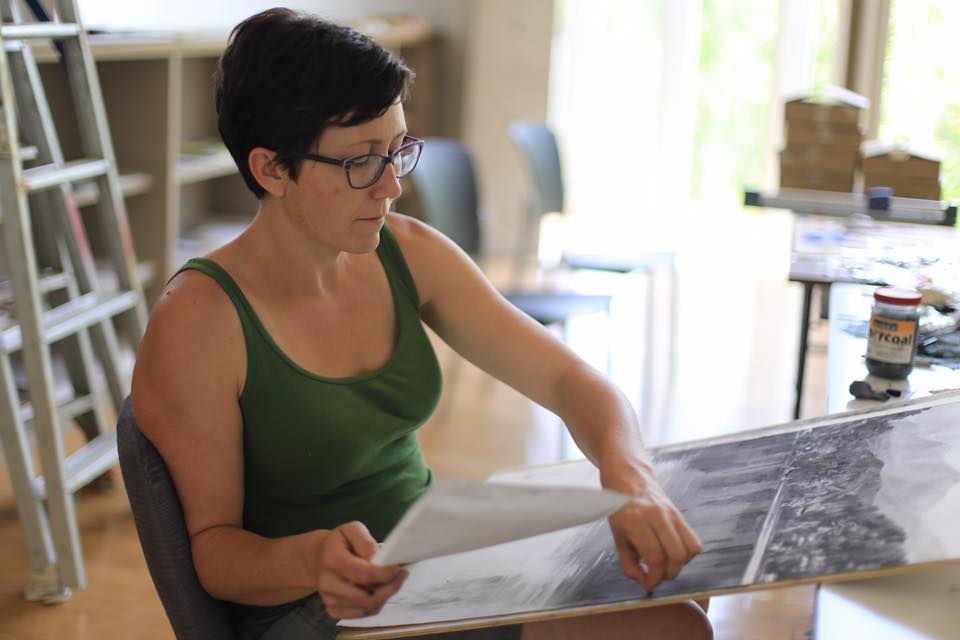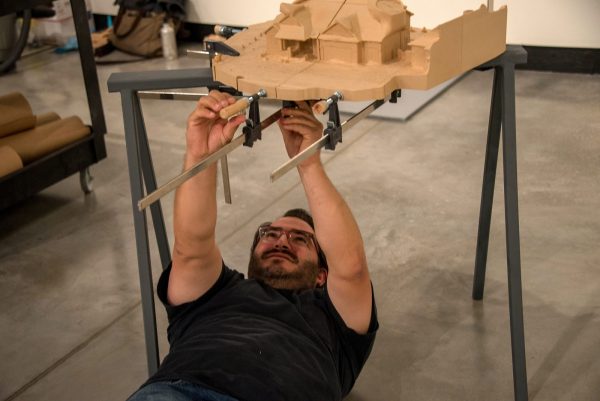Kyle Singer and Emily Sullivan most likely woke up on a school day last fall anticipating that it would be transformative. The two Colorado State University M.F.A. students are just that sort, sensing meaning and expecting eye opening moments at every turn of their education.
In Oct. 2016, Erika Osborne’s Art and Environment course started a segment titled Environmental Issues: People and Place, and the Department of Art and Art History associate professor orchestrated several field trips designed to tap into key environmental issues facing Northern Colorado.
Weld County, because it is one of the locations with the highest densities of hydraulic fracturing well pads in the nation, was the site of a field trip. “For the fracking section of the course, we begin by discussing art and activism, we look at artists who have tackled environmental issues in their work, and then we dive into the local issue of fracking. We read articles, watch films, and read scientific studies,” she explained.
The “Tour de Frack” excursion was led by Shane Davis, a ‘fractivist’ and data miner who once lived in Weld County. Also in attendance was David Brooks, an artist known for studying the relationship between individuals and the built and natural world. The Gregory Allicar Museum of Art commissioned Brooks, an environmental artist, and the New York resident was invited to select one of Osborne’s class field trips in 2016.
With the students prepared to fully engage with what they would see on the tour, class members Kyle Singer and Emily Sullivan happened to hop into the same white CSU van as Brooks and Davis and struck a rapport that had later significance.
As the class toured fracking pad sites, the camouflaged aspect of the wells and their apposition to suburban life was unsettling for many classmates. “What struck me most was the proximity,” said a solemn Sullivan. “You have a house or a playground and there is a fracking pad 100 feet away.”

Doing the Ground Work
Throughout the day, Singer and Sullivan watched as Brooks quietly observed and took notes.
It was following months of research back in New York, capped off by the Firestone site explosion in April 2017, that Brooks involved Singer and Sullivan in what evolved into the Gregory Allicar Museum of Arts’ current installation, Case Study: Weld County, Colorado, appointing them as his boots on the ground. “We were able to obtain the source imagery for David this past summer,” Sullivan stated about her connection to the early steps of the artistic process.
Reminiscent of the method Andy Warhol employed while working with a CSU graduate student in the 1980s on the well-known Campbell’s soup cans, the two students received specific instructions from Brooks on how to assist. “We did close-frame imagery and sent him the reference photos; he did all the cropping and printing from the hundreds of photos we took,” Sullivan explained.
For Singer, a critical component of David Brooks’ artistic process is his field work. “To think that David is used to field work, like in the Amazon, and we got to fulfill a portion of that part means so much,” he said.
All of the newly developed areas where Sullivan and Singer procured photos correspond with a map illustrating an underground network of active gas extraction lines below the surface. “I really don’t know if the community knows that it’s underneath – what is the mindset of the people who live there?” wondered Sullivan. “Maybe they don’t know, maybe they are just ok with it, maybe the price point [of their home] is more important.”
Meaningful Work for a Meaningful Life
“Meaningful work/meaningful life is such a great way of summarizing what I aim to get at with this course,” said Osborne, who mindfully fuses the practice of teaching art with her life routine of leaving the studio and engaging with the world around her. “This is what I try to instill in my students. They are artists studying in Northern Colorado, not New York City. So, what’s unique about this place? What authentic artistic practice can result from engaging the community and environment here? In these questions lies the ‘good stuff.’”
As the semester unfolded, Singer and Sullivan recognized that the class’s best work was in response to outside influences, such as a Forest Service project designing and fabricating bee habitats with the purpose of bolstering the North American Mason Bee population. “In addition to critical theory, the class has forced us to get involved and give back and meet people,” said Singer.
Other projects included escaping light pollution to star gaze at the Shortgrass Steppe Research Center east of Wellington, surveying the Rist Canyon burn areas and after-effects with a fire historian, trekking through Lory State Park with a landscape plotter, and visualizing the power of land preservation through buffalo population levels.
As the students created art related to prevalent environmental issues in the region, they were inspired by each other and the process, recognizing massive and rapid shifts in their work. “New ideas, new ideas, and more new ideas,” exclaimed Sullivan, whose work has evolved from traditional, landscaped based painting to be more community and environmentally oriented. “Working with David [Brooks], and taking this class has helped me contextualize where I am right now. The history of wildfires and fracking defines the place I am right now.”
This realization is exactly what Osborne expects to occur as she instructs students to apply critical analysis of their immediate world to conceptual frameworks. “It’s exhilarating for them. I think this excitement and investment comes out in the work,” said Osborne, recalling Sullivan’s poignant response to the fracking field trip – the creation of a Russian Roulette table with identical looking glasses of water except one was filled with produced water from a well pad, acquired with Shane Davis’ assistance. “She asked participants to spin the wheel and take a drink. After studying the chemicals in produced water (which looks benign but is extremely toxic), not a single student was willing!”

An Artistic Model
Singer found himself intensely interested in Brooks’ presentation of powerful ideas, realizing that hours of pouring over data is what gives the artist the right to dramatize the information in the end. “Through David’s artist talk, it was so clear how he follows his passion,” said Singer. “It may not be my passion, but I could follow his train of thought because he pinpoints what is the thing that has been percolating and how to bring out real meaning.”
For Gregory Allicar Museum of Art Director Lynn Boland, Brooks’ exhibition accomplished a key museum objective, which is fostering dialogue that resonates with a broad public interest. “Art can be a nuance when issues are particularly challenging,” says Boland. “Not to say that the artist doesn’t have an opinion personally, but it’s not our place to be dogmatic, as much as to be a catalyst for discussion.”
With Singer’s interest in the psychology of art, he agrees with the exhibition’s subtlety as an effective method of confronting confirmation bias. “Brooks’ ideas were controversial, but not overtly, and everyone became open to the conversation because they weren’t being attacked. He didn’t say that [fracking] is right or wrong, but that we need to talk about it and how to manage it in a super healthy way. It’s a very mature way to present art.”
Case Study: Weld County, CO
Open through Dec. 15, 2017, Gregory Allicar Museum of Art
University Center for the Arts, 1400 Remington St.
David Brooks, artist; Erika Osborne, exhibition curator
"How we see the landscape mirrors how we inhabit the landscape and ultimately how we consume and shape the landscape. It would follow that how we see the landscape is a reflection of the guiding ideologies of our distinct time and place. Case Study: Weld County, CO consists of re-assembled 3D prints of real homes, all lying within one hundred feet of active fracking well pads in Weld County. Image scans were taken only from what was observable from a pedestrian’s point of view, from sidewalks, roads or public paths. This restricted approach to the scanning process presented anomalies within the modeling program. When the consecutive images were assembled to form a 3D model, the software unpredictably supplemented missing information or omitted existing information. In some cases, the sky folded into rooflines and exterior space was mistaken for interior space. Such deformations make evident the disconnect between our actions and how we perceive them. This exhibition looks at how we normalize our impact on the natural world as well as the perceived consequences to our own health."
Case Study: Weld County, CO would not have been possible without the discerning eyes of Emily Boutilier Sullivan and Kyle Singer and their keen efforts in scanning the houses used here as case studies.
– Artist Statement by David Brooks

An Ideal Mentor
In addition to increasing Singer and Sullivan’s awareness about discovering and presenting environmental – and sometimes volatile – issues through their art, the time spent with Brooks informed their understanding about teaching and being professional artists, career destinations for both students. “Mentoring under such an acclaimed artist is worth its weight in gold,” proclaimed Osborne.
Brooks’ insight about funding his art, through grants, fellowships, workshops, and residencies, was invaluable for the students. Those activities, in combination with savvy packaging of his scientific research, consistently elicit support, such as Sotheby’s sponsorship of Brooks’ Desert Rooftops (2011–2012), a commissioned installation in Times Square.
“I learned about diversifying and finding ways to make it as an artist, including the necessity of being able to write about your work,” said Sullivan, who now counts the ability to convey a vision as one of the most important and practical skills she can subscribe to as a professional artist. “It was a great educational opportunity to hear about that and I can see it fitting into the schema of what I’m going to do. He gave me more tools.”
As Singer has learned, there are many ways to frame his art degree. “For me, David advocated for me to follow my dreams, but provided specific examples for figuring out my skills and marketing myself. It’s being romantic yet pragmatic at the same time.”
Looking back on the class that created so much meaning for them, the students see it as an “a-ha moment” in their education. “As artists, we can get lost in the act of making that we forget to come back to the original motivation and inspiration as the most important part, and Brooks made me remember my main motivation,” exclaimed Singer.
Learn more about the Gregory Allicar Museum.
